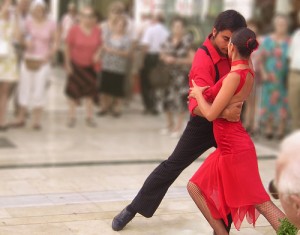
Tempo running requires focus and concentration to keep pace; just like the tango. Photo by Tango Store.
There are any number of ways to label a run and of course, you don’t have to label a run just to go running. However, in training, it’s very helpful to understand what the labels mean in order to get the most out of each work-out and maximize your performance. When I first started running the only terminology I recalled where words leftover from high school track–sprint, relay, and cross country. Until recently, my running vocabulary has been minimal at best. At some point I plan to put together a glossary of terms that I have come to understand and that seem to be an integral part of any article, website, blog, or coaching program related to running.
For now though, I’d like to focus on tempo runs. There are five types of runs on the Runner’s World triathlon training schedule and they each have a relatively helpful description. Some of the runs have the same descriptions as what one can select on many online training logs, interval and tempo for example. Even though I’ve trained for a number of races over the years, this is really the first time I am making a serious effort to follow the suggested variations in running. Rather than stick with my 9-minute pace, if the schedule tells me to run strides, I run strides. If it says hills, I run hills. And now most recently, it said to run tempo.
For a while, each week has included a run based around strides, a concept that took me some time to fully grasp. The term tempo, however, was easy enough to understand–run the designated time at a moderately fast pace, which for me meant pushing past my 9-minute pace. It was in running my first real tempo run that I realized the value of previously running strides. The strides are essentially a series of sprints alternated with recovery jogging and I think that without them, running a tempo would be extremely difficult at best. There is no doubt in my mind that because I practiced sprinting in repition I was able to maintain a faster pace for a longer period of time than normal.
I like to think of tempo running as getting into a groove. It’s not just about running at a faster pace. It’s about maintaining consistent breathing, form, and footfalls at that faster pace and focusing on keeping that pace. Sprinting is easy because you simply run as fast as you can for usually a short distance and an easy run is that slow and steady pace you could do forever. But a tempo run is harder; it requires more effort to control and I think relies on the runner getting into a zone, or groove, that allows you to run at that same faster pace step after step.
I enjoyed the challenge of the tempo run and the feeling of having to keep time, just as you would in a choreographed dance.

Nice summary. I think most people would agree with your thoughts on tempo running. When I talked about tempo running with some of my friends they had your idea, while recently I had a different approach. I’ve been using Higdon’s training plan and his tempo philosophy is:
A slightly different approach.
@crossn81
This morning I did a tempo run with a 10 min. warm-up, 20 min. tempo speed, and then a 10 min. cool down. I can safely say near the end of those 20 min. I was feeling the drain of keeping a faster pace than normal. I like Higdon’s definition too and will try that for the next tempo run. It seems the most important thing regardless of the philosophy is making sure that some runs include a race pace for a decent chunk of time rather than just short sprints. Thank you for sharing the info!